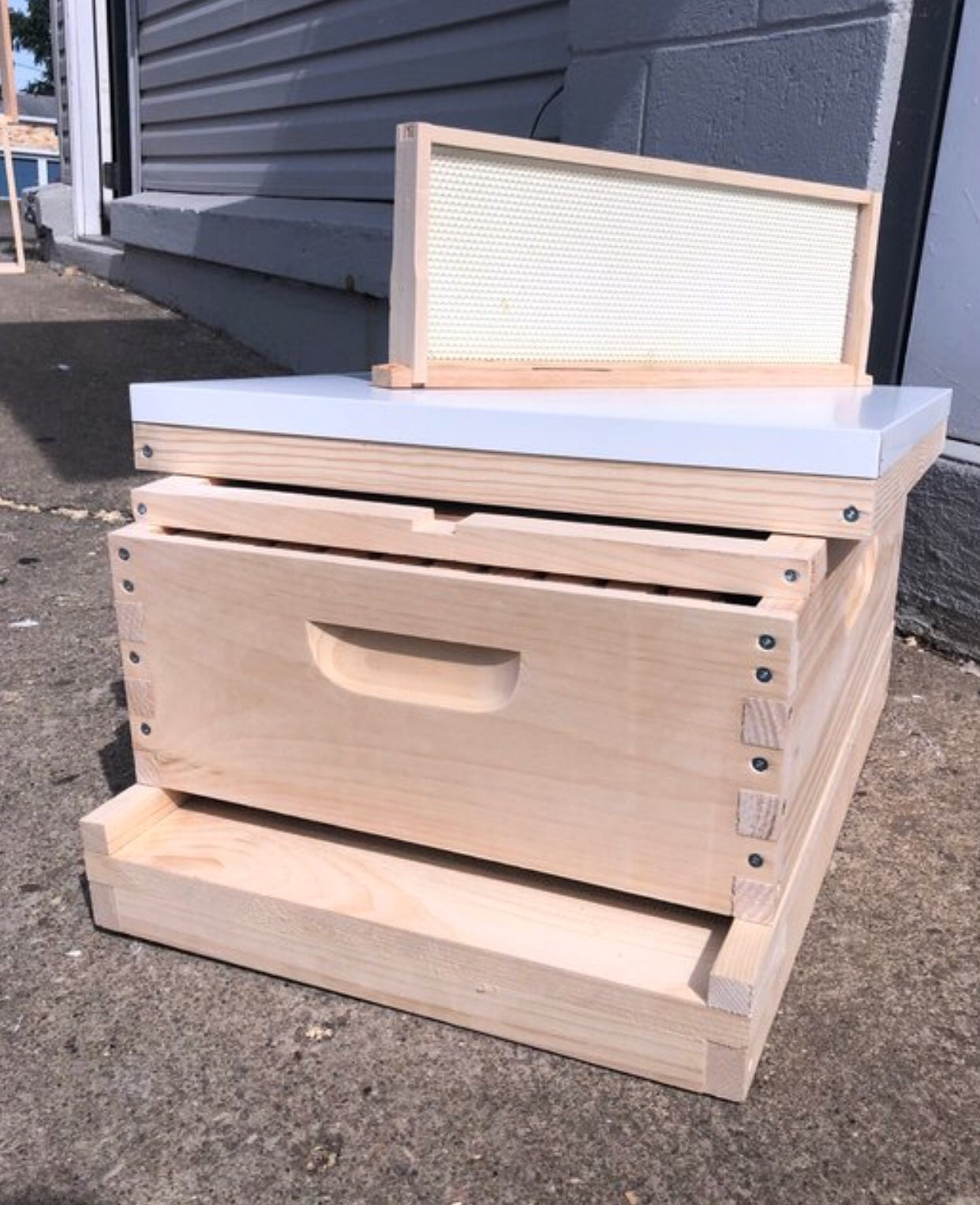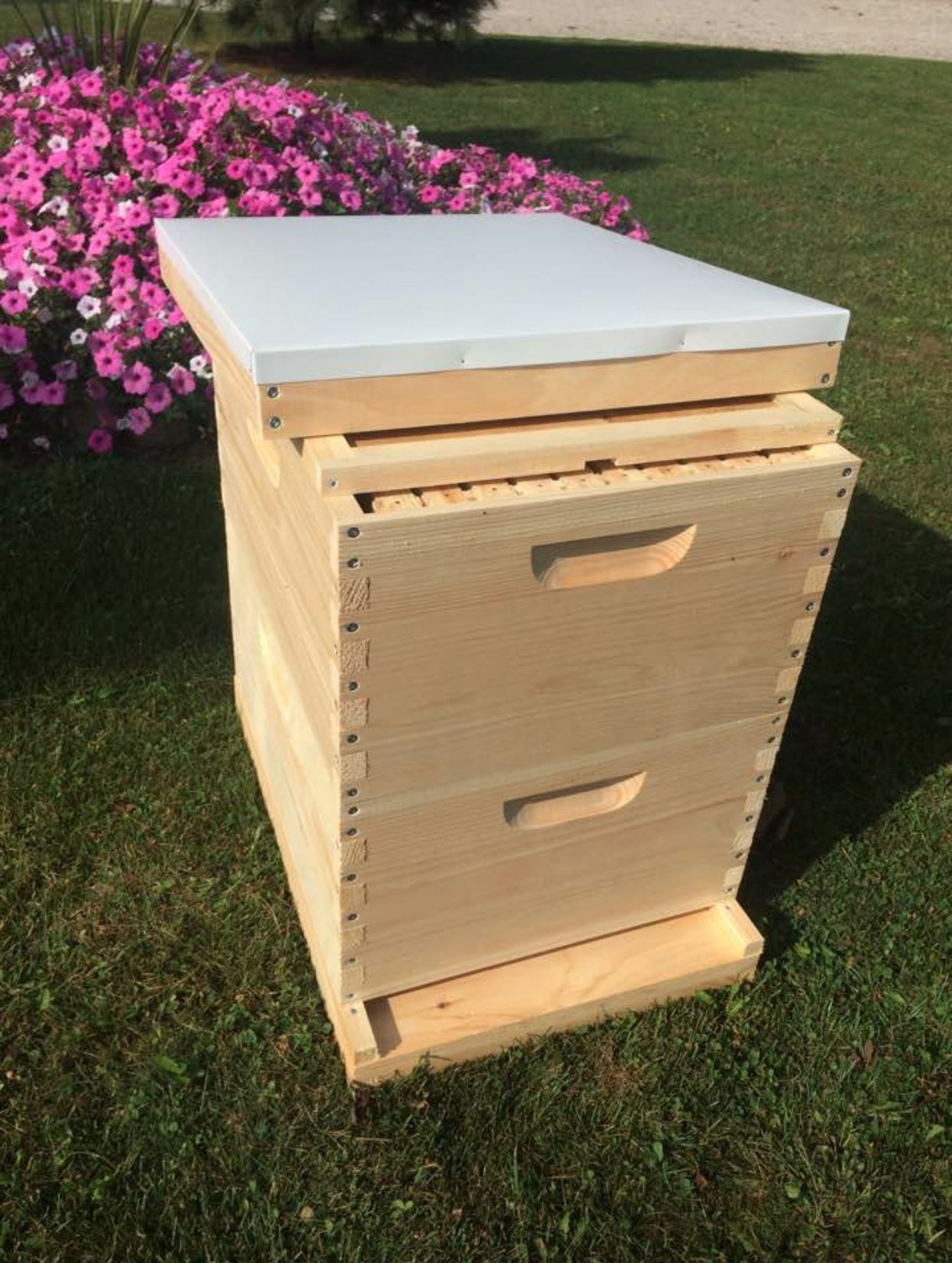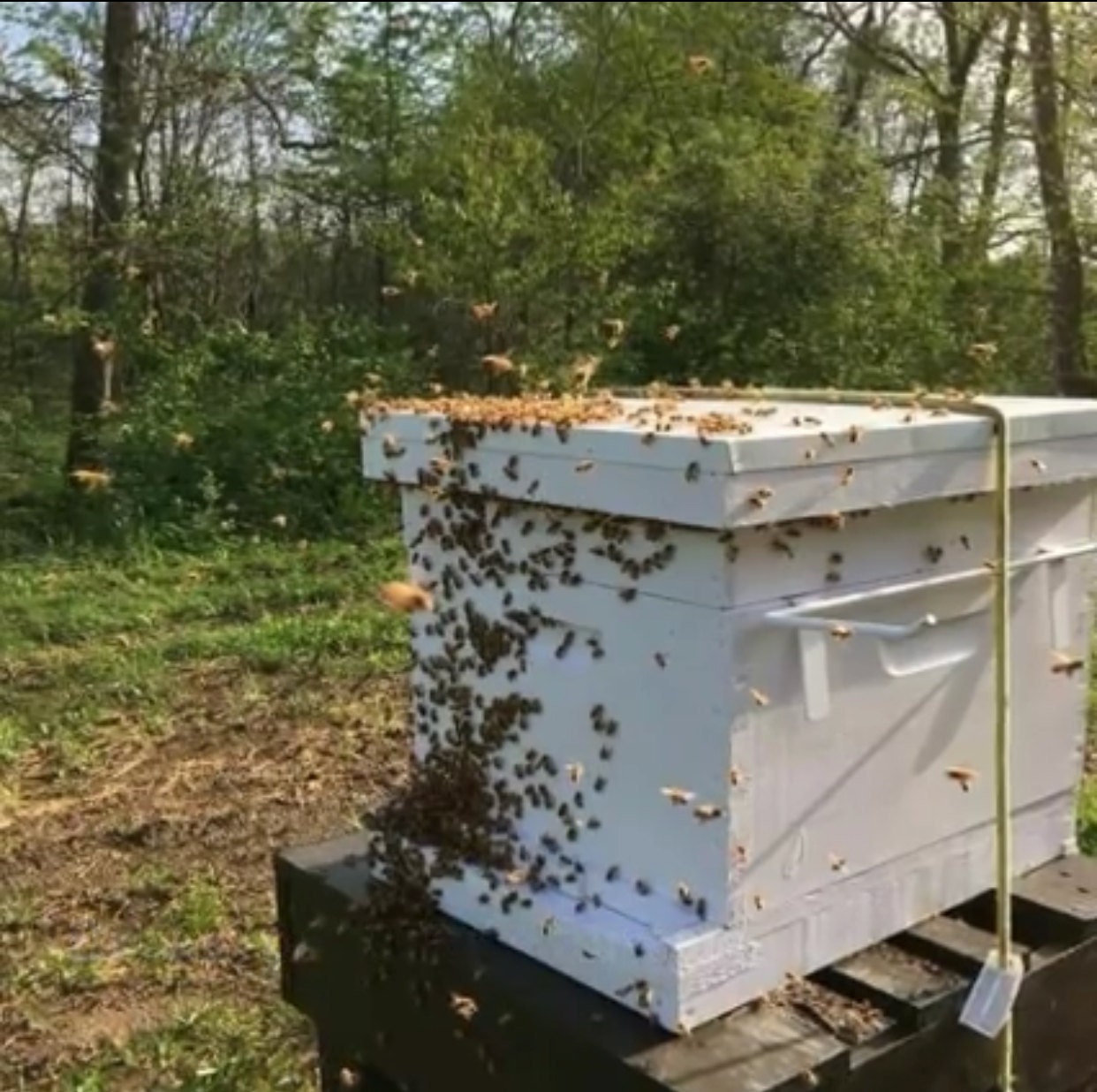Beekeeping for beginners....... This blog is for #Beekeeping and soon-to-be #Beekeepers. If you are new to beekeeping and would like to learn what's needed and involved in the beekeeping hobby, this blogs for you! We will start from the beginning as beekeeping worldwide has many different proven ways to raise #HoneyBees and be Successful doing it. 🐝🐝 So If you've been doing your research like most of us, Then you know there are several different opinions, with 25 people saying he or she is right. Not to mention, most of the time people arguing live in two different climates or regions and both being either right or wrong. Point being that there's several different ways to keep #Bees. 🐝🐝🐝🐝 I'll give my thoughts and suggestions on various topics of beekeeping and maybe you'll learn something. And if your like most #Beekeepers your ready and WILLING TO LEARN SOMETHING NEW. Sit back relax and educate yourself before jumping into something you're unprepared for. You can do more harm than good, by being a uneducated beekeeper and having a colony of bees in your backyard that pose a threat to your neighboring beekeeping community. There are several diseases and pests in the beekeeping world. As a #Beekeeper it's your responsibility to be able to identify and manage problems.. We will cover that and much more later. But first, let's educate ourselves with the basic #BeeEquipment that's needed to start. Everything you'll need to start beekeeping can be purchased on our website at
www.LittleLarueApiary.com
First-year beekeeper will need to know or have the following :
# 1 is Mandatory for all beekeepers in the United States to:
- Registered your beehives with the Department of Agriculture in the state which you live in within 10 days of receiving your bees. If you live In Ohio tap link Here to access Ohio Department of Agriculture Ohio it cost $5 per yard of bees. Each bee yard can have up to 100 colonies of bees. But you must register them. The Department of Agriculture will send an inspector to your home once a year to inspect your beehive for problems. This is a good thing because some beekeepers just let there bee sit in the backyard. Problem is neighboring bee colonies are subject to disease and pest from unmanaged beehives. Posing a huge threat to the beekeeping community. Make sure to check your local Township laws and regulations as well some places are different than others.
- #Mentor : every beginning beekeeper is Highly Recommended to follow in the footsteps of a mentor preferably one who uses very minimal protective gear. (tells you he's been doing it awhile) Mistakes are made and colonies are lost due to cross-contamination with local beekeepers. This happens when beekeepers just try to wing it. Just because you have bees in your backyard does not make you a beekeeper. The price of beekeeping alone should make you want to keep your bees in good shape any way possible. Join beekeeping groups, watch YouTube videos, and Read About Beekeeping. Because the fact of the matter is 20 years from now you will learn something new..
- #BeeSmoker : honey bees do not like the smell of white dense smoke. Beekeepers should use a couple puffs of smoke to calms the bees down. Not all beekeepers smoke their bees. However, I do recommend especially for new beekeepers. It makes the bees less aggressive and easier to work the hive for routine inspections and removing honey. I recommend using a smoker every time.
- #Hive tool : is used to open the hive, removes burr comb off the frames, scrapes off propolis. This dark red color substance resembles ( Glue ) that the bees make and is very sticky. Your bees will produce propolis throughout the entire beehive anywhere light enters and sealing all cracks and crevices. Making for a tough time separating frames, lids, boxes, inner covers, queen excluders, top feeders, from one another. (You can Harvest #Propolis with a special propolis trap) A hive tool is your best friend when attempting to open and manage your beehive.
- #Protective gear : using protective gear like gloves and suits are recommended for first-year beekeepers. Until you understand how your body will react to bee stings. If you have some unrealistic expectations about bees not stinging, beekeeping may not be for you. Getting stung is a part of beekeeping and happens nearly every time you open the hive. The better you have been taught how to handle and move around the bees, will reduce the amount of stings that occur. I recommend at minimum wearing something to protect your face as bee stings and this region of the body is extremely painful and typically swells. Gloves are an option and recommended to start without if you can. The main reason is you must get used to bee stings... It's going to happen.. Eventually it won't even bother you and won't feel it. Also the bees are a very good teacher. If you make mistakes like moving too fast, the bees will bump you and sting to remind you. It's their defense mechanism. Beekeepers tend to learn quicker to avoid the pain of stings and reduces bad habits before they start. If you do need gloves I recommend using goatskin or better yet the latex gloves for dexterity.
- #Beehive : there are several different styles of beehives available. For this article we will refer to the #Langstrath style beehive. Tap any bee hive title listed below for more pictures, details and pricing.
You will only use 1 Bee Hive body to start out. If you start with multiple boxes stacked on top of each other, your bees will probably leave relatively fast. Honey bees generate Heat by flapping their wings keeping the space inside of the hive at a certain temperature. Having too many boxes to start creates a problem because of the amount of bee space.. Too much or not enough bee space your bees will leave or die. It is vital to keep track of your bees with hive management and add boxes as needed. The bare minimum needed to start is either a

or

8/Frame or 10/Frame setup. DO NOT ONLY PURCHASE a single box set up.. You will need additional boxes before winter. If you wait until you need it to order it, Unfortunately by the time you get it, IT WILL BE TO LATE!!!! If you don't add more bee hive bodies in time, the bees won't have room to expand. When this happens they tend to #Swarm. That means over half your bees have left your bee hive and never will return. But hey swarming is Nature's Way of reproducing the honey bee. Adding additional boxes when needed is vital to the success of the Beekeeper. We call this hive management. To be successful at beekeeping it takes dedication and the willingness to learn something new. The continuous learning process will go on for years to come.
Beehives with Frames & Foundations (Recommended to start) Assembled starter bee hives with Frames and Foundations listed below
Or
(Below is set up used in Ohio **Recommended)

Buying Un-Assembled beehives with Frames and Foundations is cheaper on shipping. Listed below
or
(set up used in Ohio **Recommended)
However, Bee Hives w/Frames ONLY NO Foundations or Foundationless Frames, will work and is a cheaper way to start. I DO NOT Recommended A beginning beekeeper to start out this way.
Reason is the bees will build there comb incorrectly, creating a huge problem for the beekeeper when it's time to inspect the hive. Honey bees tend to build their comb off center making it next to Impossible to remove frames correctly. Biggest problem would be rolling or killing your queen bee. Smaller problems like having to cut and attached comb with rubber bands. If you are thinking about starting we're going foundationless, I will recommend at least putting a starter strip in the frame for the bees to have a guide. This will save you countless time and errors in the future. Below are listings of starter bee hives with Frames ONLY (NO Foundations)
Un-Assembled starter beehives
Assembled starter beehives
The term 8/Frame or 10/Frame is the reference to how many frames will be in each box. Equipment size is a preference and once you pick a size you must continue using that size. The equipment will not interchange with each other correctly. My recommendation is 10/Frame equipment. Keep in mind you will be adding boxes as needed to continue your beekeeping Adventure. First year by winter it's ideal to have at minimum two boxes of bees, brood, pollen & Honey. ( either 2 Deep , 2 Medium or a 1 Deep 1 Medium going into winter at minimum). However, 5/Frame Nucs can make it if properly done. Make sure you paint or stain your beehive equipment for Maximum lifespan. Do not paint parts that are inside your beehive like frames and Foundations. Frames are mandatory but foundation inserts are optional and recommended. Wax Foundation inserts give bees a head start and a platform to stand on Guiding the bees to build comb inside the frame correctly. Using empty frames or foundationless frames is okay, but problems can and will occur from the bees building the comb incorrectly on the frame making for a beekeepers nightmare. If this happens it is your responsibility to cut and remove and repair the comb inside the frame correctly (I temporarily use rubber bands to hold the comb until bees reattach) so that removal of the frames is possible for beehive inspections. If the bees cross-comb it's hard for The Beekeeper to remove the frame from the beehive without damaging the comb. It is fixable just time-consuming and messy process. If you choose to go Foundationless or with empty frames, I would recommend using at least a starter strip for the bees to use as a guide. Also plastic foundation is recommended primarily for the ability to withstand extraction of the honey without damaging comb so The Beekeeper can return into hive the bees to store or honey. Real wax foundation tends to shred during extraction process. Making the bees have to start from scratch and a waste of time in my book. I am not saying wax foundation is bad. Just saying my preference from using both. Make sure if you're using plastic Foundation to only use pre-waxed Foundation. The bees don't like the smell of plastic. If you purchase plastic Foundation that is not wax coated simply coat outside of foundation with wax. And the bees will accept it without any issues. Do not mix match frames in the hive, meaning some plastic some wax. The bees will pick one kind and refuse the other. Keep in mind you give them an option they're going to take one. Try and keep the same consistency in the hive..
Your basic beehive components needed are:
** next to equipment name is my recommendation for that component
- Top Cover (**Telescopic or Migratory)
- Inner covers (screen or *regular)
- Medium 6 5/8 honey supers (used for collecting honey)
- 6 1/4 medium frames (Groove and **Wedge Style Bees Build comb inside )
- Deep 9 5/8 brood Hive bodies (eggs, larvae & brood)
- 9 1/8 Deep Frame (Groove and **Wedge Style Bees Build comb inside )
- Foundation inserts (**Plastic wax coated or real Wax Foundation)
- Beehive bottoms (Solid or **Screen bottom)
- entrance reducer (used to reduce entrance size)
- **Hive Stands (optional but recommended ) Do NOT put several beehives on one Hive stand. Make sure each Hive has its own separate Hive stand. Bees detect motion and vibration. Using only one Hive stand creates problems when you try to do hive inspections once you open first hive the rest of the beehives are alarm from the vibrations.
- **Bee hive feeders (Entrance feeder, Frame feeders, **Top Hive Feeders) make sure you feed your bees sugar syrup or substitute like Honey Bee Healthy and pollen patties the first year. Remember your main goal the first year is to get your bees through the upcoming winter. If you don't feed there's a good possibility they won't make it. Second-year feeding is different because you don't want sugar honey. Do not take their honey the first year they need it!!!!!!
Photos provided in this Blog, are what Top-Quality BeeHives should look like... Dont be tricked by the price!
Beekeeping companies usually provide a couple different ways to buy beehives. Meaning what does the wood look like. Knots in wooden bee hive parts will extremely reduce the lifespan. The knots will shrink over short time and create gaps and or completely fall out weakening the structure of the hive. It's one of those things get what you pay for. Below are some terms used purchasing equipment from beekeeping companies. If possible purchase unassembled equipment to save on shipping cost. Its relatively easy to assemble beehives. Makes for a great family adventure as well. Highly recommended to use screws on the boxes because nails tend to rust and fall out. Just another important factor when shopping for beehives. ( primarily assembled ) We screw all of our beehive box equipment. (zinc plated screws) We also use 1 inch staples in all four corners of the frames. All our beehive parts are glued with Titebond II wood glue..
- Budget (several extremely large knots, cheap & crappy)
- Economy (a few select knots usually smaller than quarter)
- Select
* *Select (Usually knot free & the only way we build our hives) so don't be fooled when price checking different companies make sure you know what kind of wood you are getting for that price. At Little Larue Apiary LLc, We only offer Select type woodenware. Top-Quality all the way.
Extremely important to start with two beehives.
*****Purchase 2 beehives at once because when starting beekeeping a new beekeeper usually has no idea and cannot identify problems. Having a second beehive gives the advantage to the new beekeeper by having the ability to compare one beehive to the other. This advantage is vital when identifying problems as most beehives have separate problems. With two beehives you're more likely to see a difference realizing there may be a problem. Not to mention if you lose your queen bee while having two hives, you can replace her. Honey Bees can create a new queen bee from one day old eggs from second hive of brood replaced into queenless hive. Saving the beekeeper time, money and valuable bees that will be lost without a queen. If you lose your queen and can't purchase a fertilized laying #QueenBee, It take up to 28 days to replace her back to A productive laying queen. (after installing frame with 1 day old eggs). In that time, half to three quarters of your bees will perish. Depleting the population of your beehive. Making survival during winter time next to Impossible without a relatively large colony of bees. As your bees depend on each other to keep warm by flapping their wings and creating heat in a cluster. The life span of a worker bee is four to six weeks in the summer time & 4 to 6 months in the winter time. Without a second colony of bees available or a way to purchase a laying Queen, Your bees WILL DIE. Just start with two hives save yourself some troubles.
Beekeeping equipment that is optional.
- Queen excluder : more than likely you will not need a queen excluder for your first year. Remember the first year is building your hive up so they can make it going into a winter. If you have plans of taking your bees honey the first year you probably won't have these come summertime. They are used at the beginning of the second year, and removed before winter or your bees will die. Remember bees work in a circle sphere moving up and down depending on the season. If your queen excluder is left on in the winter the bees cannot go up to feed because they are staying with the queen who cannot get through the queen excluder. hey will starve to death. These are an option and not mandatory. They keep the queen from laying eggs in the #Honey Supers. As you cannot extract honey that has eggs, larva or capped brood in it. Ruins the taste.....
Diseases, Parasites & Virus info: VERY IMPORTANT INFO!!
Problems associated with the Honey Bees
- Colony collapse Disorder
Bacterial disease
- European foulbrood disease
- American foulbrood disease
Pests & Parasites
- Varroa mite
- Acarine ( tracheal ) mites
- Wax moths
- Nosema
- Small hive beetle
- Tropilaelaps
Fungal diseases
- Sacbrood disease
- Chalkbrood Disease
Viral diseases
- Deformed Wing virus
- Sacbrood virus
- Dicistroviridae
- Cloudy Wing virus
- Black queen cell virus
- Cripaviridae
- Acute bee paralysis virus
- Chronic bee paralysis virus
- Israeli acute paralysis virus
- Kashmir bee virus
- Ifaviridae
- Kakugo virus
- Iridoviridae
- Invertebrate iridescent virus type 6
- Lake Sinai virus
- Tobacco ringspot virus
- Secoviridae
Just to name a few....HaHaHa!!!! I know that's a lot. Don't worry you'll never encounter or identify over half this list. However, there are a few on the list that pose an immediate threat to your bee colony and your neighboring colonies. It's our job as a beekeeper to identify and treat problems in a timely manner. This applies to treatment free and natural beekeeping...

